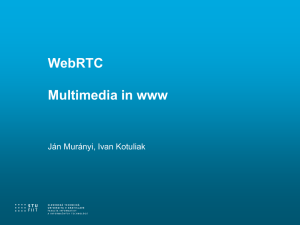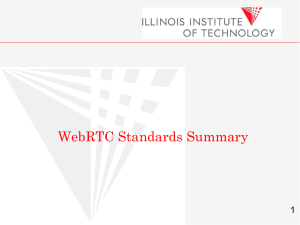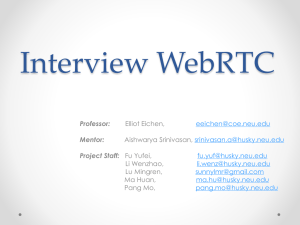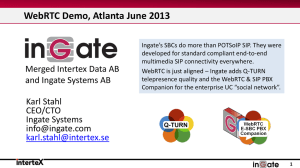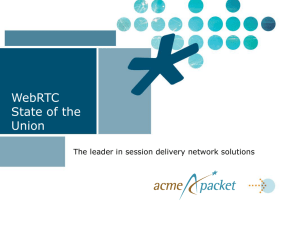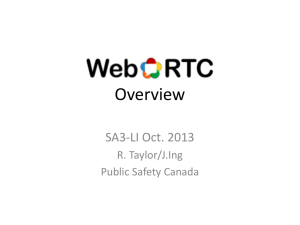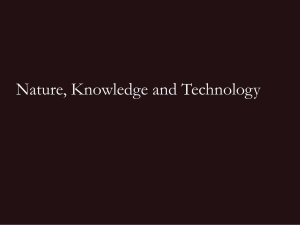WebRTC
advertisement
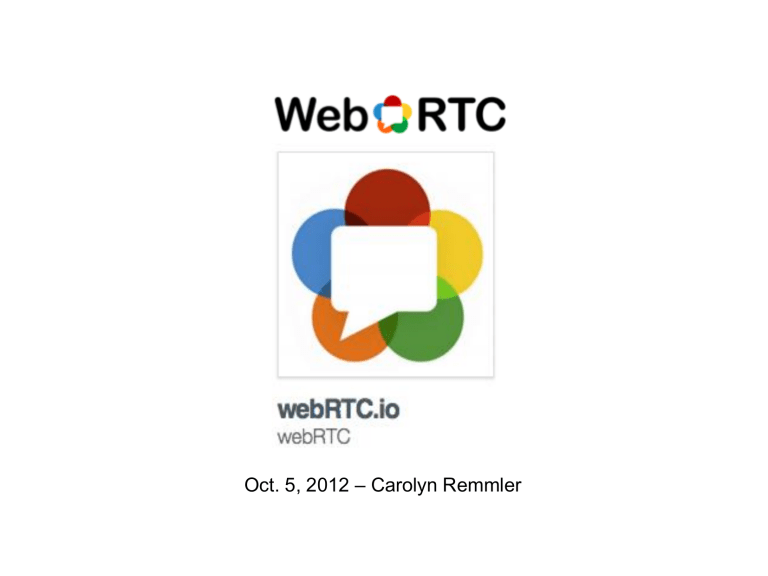
Oct. 5, 2012 – Carolyn Remmler
Current Work
Educational Software
Browser-based games
Multi-player games
Websockets (NodeJS, socket.io)
Other Javascript Libraries
- Box2dWeb.js
- Kinetic.js
- JSXGraph.js
- jQuery SVG Plug-in
Past Work
High School Math Teacher
Stained Glass Artisan
What is WebRTC?
Web Browsers with Real-Time-Communication
● Audio/Video Chat on the web.
● Accessed through Javascript API.
● Does not require plugins, downloads or installs.
● Multiple browsers, multiple platforms.
http://www.webrtc.org/faq
How did we get here?
Graphic by Jimmy Lee / jimmylee.info
http://venturebeat.com/2012/08/13/webrtc-is-almost-here-and-it-will-change-the-web/
Javascript Session Establishment Protocol
Peer-to-peer exchange of data
Justin Uberti, Tech Lead, WebRTC,
http://www.youtube.com/watch?v=E8C8ouiXHHk
We can use webRTC.io!
Justin Uberti, Tech Lead, WebRTC,
http://www.youtube.com/watch?v=E8C8ouiXHHk
Who can use WebRTC? How?
http://www.webrtc.org/running-the-demos
Justin Uberti, Tech Lead, WebRTC,
http://www.youtube.com/watch?v=E8C8ouiXHHk
But wait... If WebRTC isn't on mobile, yet, what is
this guy doing?
It is an open source HTML5 Sip Client.
http://www.sipml5.org/index.html
Instead of using webRTC.io, they used Javascript to
implement the SIP Protocol.
Justin Uberti, Tech Lead, WebRTC,
http://www.youtube.com/watch?v=E8C8ouiXHHk
But we just want to implement audio/video chat in a
browser!
Let's use webRTC.io!
It's an abstraction layer for webRTC.
webRTC.io is to WebRTC as
socket.io is to WebSockets
https://github.com/webRTC/webRTC.io
Let's use webRTC.io to access WebRTC!
How does it work?
● MediaStreams – access to user's camera and mic
● PeerConnection – audio/video calls
● DataChannels – p2p application data transfer
MediaStreams
PeerConnection
DataChannels
Let's make a WebRTC mirror!
<script src='webrtc.io.js'></script>
<!-- from https://github.com/webRTC/webrtc.io-client -->
generative.edb.utexas.edu/webrtc-demos/mirror.html
MediaStreams
PeerConnection
Add a Video Tag.
<video id="me" autoplay></video>
Flip Video to show mirror image.
#me { -webkit-transform: rotateY(180deg); }
DataChannels
MediaStreams
PeerConnection
DataChannels
Display my video stream.
var PeerConnection = window.PeerConnection ||
window.webkitPeerConnection00;
if (PeerConnection) {
rtc.createStream({"video": true, "audio": true},
function(stream) {
rtc.attachStream(stream, 'me'); // <video id="me">
});
} else {
alert("Please use a WebRTC-enabled browser.");
}
MediaStreams
PeerConnection
DataChannels
Let's lighten and darken the mirror,
in real time!
<script src='webrtc.io.js'></script>
MediaStreams
PeerConnection
DataChannels
Add buttons.
<button id='lighten'>Lighten</button>
<button id='darken'>Darken</button>
Lighten and darken the mirror.
$('#lighten').bind('click',function() {
if (videoOpacity > 0) {videoOpacity = videoOpacity - 0.1;}
$('#me').css('opacity',videoOpacity); // <video id="me">
});
$('#darken').bind('click',function() {
if (videoOpacity < 1) { videoOpacity = videoOpacity + 0.1;}
$('#me').css('opacity',videoOpacity);
});
MediaStreams
PeerConnection
DataChannels
Let's make a WebRTC Photo Booth!
<script src='webrtc.io.js'></script>
generative.edb.utexas.edu/webrtc-demos/photobooth.html
MediaStreams
PeerConnection
DataChannels
Add video and canvas tags, and a snapshot
button.
<video id="me" autoplay></video>
<canvas id=”snapshot”></canvas>
<button id=”snapPicture”>Snapshot</button>
Create Video and Canvas Objects.
var myVideo = document.getElementById("me");
var snapshotCanvas = document.getElementById("snapshot");
generative.edb.utexas.edu/webrtc-demos/photobooth.html
MediaStreams
PeerConnection
DataChannels
Take a frame of the video. Add it to the canvas.
$('#snapPicture').bind('click', function() {
snapshotCanvas // to <canvas id='snapshot'>
.getContext('2d')
.drawImage(myVideo, 0, 0, // from <video id="me">
snapshotCanvas.width,
snapshotCanvas.height);
});
MediaStreams
PeerConnection
DataChannels
Let's make an Embossed WebRTC Mirror!
<script src='webrtc.io.js'></script>
<script src='seriously.js'></script>
<!-- from https://github.com/brianchirls/Seriously.js/ -->
generative.edb.utexas.edu/webrtc-demos/emboss.html
MediaStreams
PeerConnection
DataChannels
Add video and canvas tags.
<video id="me" autoplay></video>
<canvas id=”snapshot”></canvas>
Take video frame. Add emboss affect.
Draw it on canvas.
seriously = new Seriously();
myVideo = seriously.source(“#me”); // source video
target = seriously.target('#snapshot'); // target canvas
emboss = seriously.effect('emboss');
emboss.source = myVideo; // emboss video frame
target.source = emboss; // draw to canvas
seriously.go();
MediaStreams
PeerConnection
DataChannels
Let's Add Goofy WebRTC Glasses!
<script src='webrtc.io.js'></script>
<script src='ccv.js'></script>
<script src='face.js'></script>
<!-- from https://github.com/liuliu/ccv -->
MediaStreams
PeerConnection
DataChannels
Add video and canvas tags.
<video id="me" autoplay></video>
<canvas id=”snapshot”></canvas>
Load glasses image.
var glassses = new Image();
glasses.src = 'glasses2.png';
Keep detecting and drawing glasses.
playing = setInterval(function() {
showGlasses();
}, 200);
MediaStreams
PeerConnection
DataChannels
Draw video frame on canvas.
snapshotCanvas.getContext('2d')
.drawImage(myVideo,0,0,
snapshotCanvas.width, snapshotCanvas.height);
.
MediaStreams
PeerConnection
Detect face(s).
comp = ccv.detect_objects({
canvas: snapshotCanvas,
cascade: cascade,
interval: 4,
min_neighbors: 1
});
Draw glasses on canvas.
.
for (i = comp.length; i--; ) {
snapshotCanvas.getContext('2d')
.drawImage(glasses, comp[i].x, comp[i].y,
comp[i].width, comp[i].height);
}
DataChannels
MediaStreams
PeerConnection
DataChannels
Let's see the audio in real time!
<script src='webrtc.io.js'></script>
<!-- Chrome 23. Enable Web Audio Input. -->
MediaStreams
PeerConnection
DataChannels
Add video and canvas tags.
<video id="me" autoplay></video>
<canvas id=”results”></canvas>
Define Buffer and Create Canvas Objects.
var buflen = 1024;
var buf = new Uint8Array( buflen );
var canvas = document.getElementById('results');
var ctx = canvas.getContext('2d');
MediaStreams
PeerConnection
DataChannels
Attach the stream.
rtc.attachStream(stream, 'me'); // from video
Create an audio node from the stream.
audioContext = new webkitAudioContext();
mediaStreamSource =
audioContext.createMediaStreamSource( stream );
Connect it to another node for processing.
analyser = audioContext.createAnalyser();
analyser.fftSize = 2048;
mediaStreamSource.connect( analyser );
// output audio through analyzer
MediaStreams
PeerConnection
DataChannels
Process buffer.
analyser.getByteTimeDomainData( buf );
// or analyser.getByteFrequencyData( buf );
Draw buffer data on canvas.
ctx.clearRect(0, 0, canvas.width, canvas.height);
for (i=0;i<buf.length;i++) {
ctx.beginPath();
ctx.moveTo(i/2,200);
ctx.lineTo(i/2,200-buf[i]);
ctx.stroke();
}
MediaStreams
PeerConnection
DataChannels
Keep updating sound.
function updateSound() {
// Add code to process buffer and draw to canvas.
rafID =
window.webkitRequestAnimationFrame( updateSound );
}
MediaStreams
PeerConnection
DataChannels
WebRTC Speech Recognition
Having fun?
By Jos Dirkson
1. Stream live audio with WebRTC
2. Record small WAV files with RecorderJS
3. Send WAV files to server with websockets
4. Convert WAV to FLAC with JavaFlacEncoder
5. Send audio in FLAC format to Undocumented Google API
6. Receive JSON string
“having fun”
http://www.smartjava.org/content/record-audio-using-webrtc-chrome-and-speechrecognition-websockets
MediaStreams
PeerConnection
DataChannels
Let's make a Video Call!
<script src='webrtc.io.js'></script>
generative.edb.utexas.edu/webrtc-demos/videocall.html
MediaStreams
PeerConnection
DataChannels
My Client
http://generative
.edb.utexas.edu
/webrtc-demos
/videocall.html
calls
webrtc.io.js
requires
(client version)
Our Node.js Server
http://generative
.edb.utexas.edu
:60020
webrtc.io.js
requires
(server version)
generative.edb.utexas.edu/webrtc-demos/videocall.html
MediaStreams
PeerConnection
DataChannels
Add our video tags.
<video id="me" autoplay></video>
<video id="you" autoplay></video>
Display my video stream.
if (PeerConnection) {
rtc.createStream({"video": true, "audio": true},
function(stream) {
rtc.attachStream(stream, 'me');
});
} else {
alert("Please use a WebRTC-enabled browser.");
}
MediaStreams
PeerConnection
DataChannels
Add a New Room button.
<button id='newRoom'>Create a New Room</button>
Create a new room.
$('#newRoom').bind('click', function() {
var randomString = createRandomString(); // = 'foo'
window.location.hash = randomString;
location.reload();
});
// From generative.edb.utexas.edu/webrtc-demos/videocall.html
// to generative.edb.utexas.edu/webrt-demos/videocall.html#foo
MediaStreams
PeerConnection
DataChannels
Find which room I'm in.
var room = window.location.hash.slice(1); // 'foo'
Connect to that room.
rtc.connect("ws://generative.edb.utexas.edu:60020",room);
Listen for a peer.
rtc.on('add remote stream', function(stream,socketId) {
console.log('peer ' + socketID + ' joined');
rtc.attachStream(stream,"you"); // <video id="you">
});
rtc.on('disconnect stream', function(data) {
console.log('peer ' + data + ' disconnected');
});
MediaStreams
PeerConnection
Run my Node.js server.
var app = require('express').createServer();
app.listen(60020); // port 60020, just because
var webRTC = require('webrtc.io').listen(app);
// from
DataChannels
MediaStreams
PeerConnection
DataChannels
Listen to events on the Node.js server.
webRTC.rtc.on('connect', function(rtc) {
console.log('user connected');
});
webRTC.rtc.on('send answer', function(rtc) {
console.log('answer sent');
});
webRTC.rtc.on('disconnect', function(rtc) {
console.log('user disconnected');
});
MediaStreams
PeerConnection
DataChannels
Send plain data with my Nurse Line App!
I used socket.io for Websockets.
generative.edb.utexas.edu/webrtc/
MediaStreams
PeerConnection
DataChannels
DataChannels are coming soon!
Can replace websockets connection for sending data.
It will have:
● Peer-to-peer exchange of data
● Low latency
● High message rate/throughput
● Optional unreliable semantics
Justin Uberti, Tech Lead, WebRTC, http://www.youtube.com/watch?v=E8C8ouiXHHk
MediaStreams
PeerConnection
Mesh
Justin Uberti, WebRTC
DataChannels
MediaStreams
PeerConnection
Tree
Justin Uberti, WebRTC
DataChannels
MediaStreams
PeerConnection
DataChannels
Comparing WebSockets and DataChannels!
WebSockets
Share events with server.
Broadcast to rooms.
Save client-specific data.
Send volatile messages.
Most current browsers.
Firewall issues.
Can run locally.
WebRTC
Share session info with server.
Share audio/video data with peer.
Broadcast to rooms.
Sure.
Send volatile messages.
Chrome, for now.
?
Can run locally.
generative.edb.utexas.edu/webrtc-demos/
